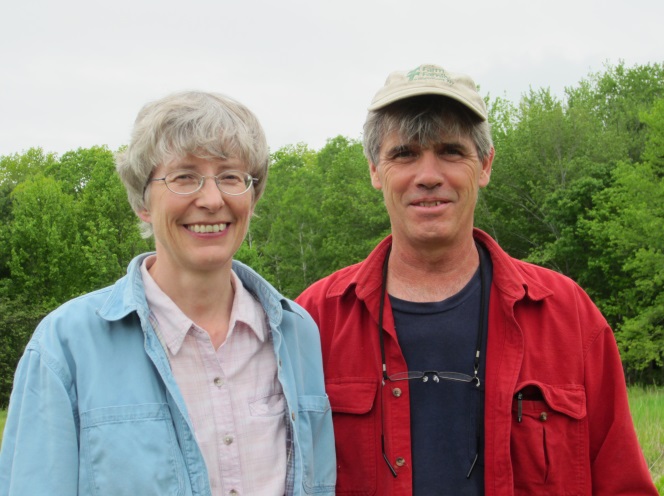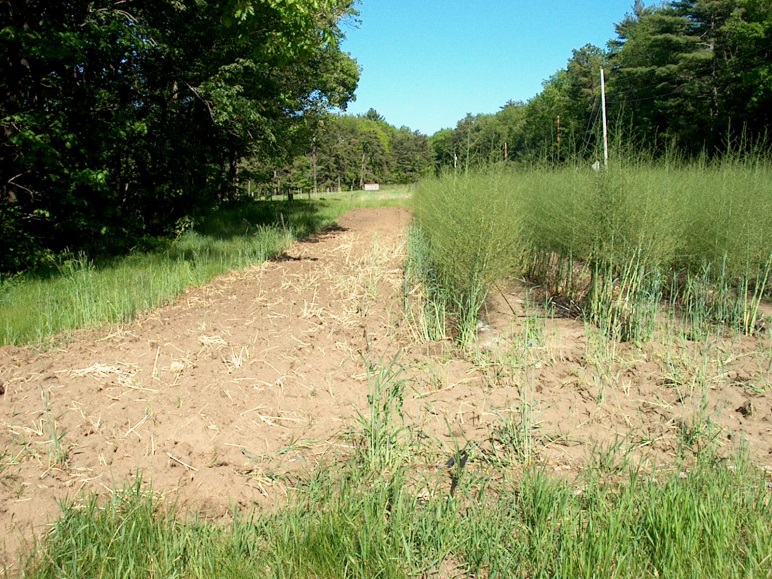Using Chickens and Cover Crops to Control Weeds in Asparagus
Marilyn and Rick Stanley use chickens and a 10-foot-wide border to significantly reduce weeds in their asparagus fields.
SARE GRANT FNE09-671
Written by Anne de Ferron, Graduate Student, French National Agronomic School of Toulouse, France
The Farm

Chick Farm is tucked in the woods of the southern coastal town of Wells, Maine. Here, the Stanleys produce eggs and layer hens, and own about 10 acre of pasture, a 160 acre woodlot, and just over one acre of cultivated land. All their products are certified organic and are distributed through on-farm and farmers’ market sales.
Rick and Marilyn were looking for a high value crop that could thrive in their sandy and well-drained soil. Asparagus, being a long-term perennial that requires good drainage, appeared to be the ideal cash crop. As for most organic and perennial crops, effective weed control is imperative for successful asparagus production yet time consuming and labor intensive. It occurred to Marilyn and Rick that they could call on their chickens to help manage the weed population.
The SARE project
The Stanleys observed promising results after an informal try with the chickens in an old asparagus field, thus triggering their application for a 2-years SARE grant. They received $7,175 to cover the trial expenses, test the methods and share their results. The grant allowed them to focus on three questions:
1) Can chickens be used to forage weeds in asparagus? This objective also included developing guidelines for how to use the chickens efficiently (e.g., how long to keep chickens in a particular field, how many chickens to use, and which breed is the most suitable), as well as evaluating the chickens’ impact on asparagus beetles. Each field was divided in two parts. They used chickens to forage weeds on one half; on the other they did their customary hand-weeding.
2) Are cropped borders effective to prevent quack grass growth? The Stanleys maintained a 10-foot-wide border around their fields in which they seeded either oat or winter rye in the fall. These borders were then tilled in the spring and late summer. In some areas, vegetable crops were grown during the summer season.
3) Can straw replace hay as a mulch? Hay mulch, though less expensive, usually contains a lot of weed seeds. The Stanleys thought a combined use of chickens, border crop and mulch could be a successful and inexpensive management practice to control weeds in asparagus. An added benefit would be the nutrients and organic matter added with the straw. However, despite careful watering, the weed seeds from the mulch did not germinate, thus making the comparison impossible to test.
The results
1) Do chickens control weeds? Yes

The effects of using chickens to manage weeds are seen clearly in this photo. Chickens significantly reduced weed density, without damaging the asparagus. According to the Stanleys measurements, weed numbers dropped by 19, 55, and 90% after chickens foraged for 4 to 10 weeks in the three trials they conducted, while they saw no impact of the chickens on asparagus crown diameter, height, and shoot number.
Based on these results, the Stanleys continue to use their chickens to manage weeds in asparagus. They recommend using 8 to 15 chickens per 1000 sq ft. with the length of time depending on weed population and chicken behavior (which depends on age and breed).
2) Does a barrier crop suppress quackgrass growth? Yes

Marilyn and Rick were pleased with the results from the border crop experiment. The 10’ borders effectively blocked quackgrass from migrating into their asparagus fields. This was equally true whether the borders were seeded to oat, rye, or even annual vegetable crops. The Stanleys recommend the border be at least 4 feet wide and be tilled at least twice per season.
Summary
Overall, Marilyn and Rick Stanley are pleased with their project’s outcomes and the SARE grant process: data collection was quick and easy, and while writing the report took some time, the SARE guidelines were very helpful. The grant covered all trial expenses and helped them solve a key problem on their farm. To date, they continue to use weeder chickens and border crops in asparagus fields with great success. The next step could be to apply for a new SARE grant: would the chickens be effective in raspberries too?
For more information about this project, see the Stanley’s SARE project description and reports.
For more information about Northeast SARE Farmer Grants, see the NE-SARE website.
